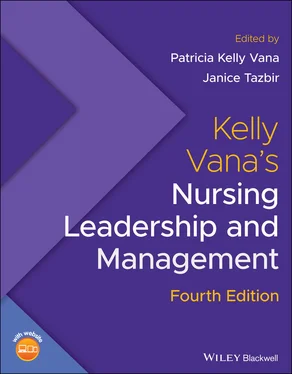The three hospital accrediting agencies address patient safety. These agencies include Det Norske Veritas Healthcare, Inc. (DNV), Healthcare Facilities Accreditation Program(HFAP), and TJC.
Det Norske Veritas Healthcare, Inc.
Det Norske Veritas Healthcare, Inc. (DNV)empowers quality and patient safety through an outcomes‐based accreditation program. They received authority from the Centers for Medicare and Medicaid(CMS) to provide accreditation to hospitals in 2008, and integrate the CMS Conditions of Participation with the ISO 9001 Quality Management Program. The ISO 9001 quality system is a structured way of delivering a better service or product, supported by detailed procedures such as work instructions, quality manuals, and written quality policies to provide all employees with detailed, understandable, and workable instructions that define expectations and actions to achieve the stated quality goals. DNV's goal is to enable a broader culture change toward high performance and continual improvement by combining the mandatory CMS evaluation with a quality management system into one seamless program (DNV, 2018).
Healthcare Facilities Accredition Program
Healthcare Facilities Accredition Program( HFAP) was originally created in 1945 to conduct an objective review of services provided by osteopathic hospitals. In 1965, HFAP received authority from the Centers for Medicare and Medicaid to provide accreditation to hospitals, ambulatory care/surgical facilities, mental health facilities, physical rehabilitation facilities, clinical laboratories, and critical access hospitals. HFAP adopted the 34 Safe Practices set forth by the National Quality Forum (NQF) in 2009 (HFAP, 2017).
The mission of TJCis to continuously improve health care for the public, in collaboration with other stakeholders, by evaluating health care organizations and inspiring them to excel in providing safe and effective care of the highest quality and value (TJC, 2018a, 2018b, 2018c). Founded in 1951, TJC uses the Donabedian conceptual framework of structure, process, and outcomes to assess an organization. TJC (March 1, 2017) identified 11 leader expectations for developing a safety culture, as outlined in Table 4.7. These expectations are very appropriate for nurse leaders in every level of an organization.
Table 4.7 Joint Commission Expectations for Leaders in Developing a Safety Culture
| Create a transparent, non‐punitive approach to reporting and learning from adverse events, close calls, and unsafe conditions.Establish clear, just, and transparent risk‐based processes for recognizing and separating human error and error arising from poorly designed systems from unsafe or reckless actions that are blameworthy.Adopt and model appropriate behaviors and champion efforts to eradicate intimidating behaviors.Establish, enforce, and communicate to all team members the policies that support safety culture and the reporting of adverse events, close calls, and unsafe conditions.Recognize team members who report adverse events and close calls, who identify unsafe conditions, or have good suggestions for safety improvements.Establish an organizational baseline measure on safety culture performance using the Agency for Healthcare Research and Quality (AHRQ) Hospital Survey on Patient Safety Culture or another tool, such as the Safety Attitudes Questionnaire.Analyze safety culture survey results from across the organization to find opportunities for quality and safety improvement.Develop and implement unit‐based quality and safety improvement initiatives designed to improve the culture of safety.Embed safety culture team training into quality improvement projects and organizational processes to strengthen safety systems.Proactively assess system strength and vulnerabilities and prioritize them for enhancement or improvement.Repeat organizational assessment of safety culture every 18 to 24 months to review progress and sustain improvement. |
Source: The Joint Commission. (2018b). 2019 Hospital National Patient Safety Goals. Retrieved from www.jointcommission.org/assets/1/6/2019_HAP_NPSGs_final.pdf.
The journey toward high reliability is complex and involves every aspect of an organization. The role of the governance or the board of directors is essential. Table 4.8identifies questions board members should ask to ensure that the health care organization is focused on safety (American College of Healthcare Executive, 2017). Nurse leaders must put resources in place and create a culture so that these questions can be answered affirmatively.
Table 4.8 Questions to Confirm a Healthcare Organization's Focus on Safety
| Is safety positioned as an uncompromising core value?Is there a comprehensive plan for improving patient and workplace safety and for monitoring progress?Is transparency embraced for sharing adverse patient safety events and lessons learned across the system?Is there a healthy reporting environment and a fair and just culture?Is respect expected for patients, co‐workers, and physicians within the organization?Are patient stories heard regularly?Are quality and safety implications considered for every major organizational decision?Does the board of directors or governance structure devote sufficient time to safety, quality, and the patient experience of care? |
Source: Patti Ludwig‐Beymer.
Becoming an HRO involves creating a culture of safety and reliability. This type of culture improves safety, an important element for an effective, efficient health care system .Similarly, a culture of high reliability enhances quality. In addition, a culture of reliability enhances the patient experience. Afterall, what patients or family member is pleased if their care is unsafe or of poor quality? Last, a culture of safety and reliability improves the financial performance of a health care organization.
Much of the early work on safety and high reliability was done in other industries, like commercial aviation and nuclear power. These industries experienced major safety improvements because of their focus on high reliability principles. Health care organizations can apply what has been learned in other safety‐focused industries to improve patient safety.
Regardless of role and setting, nurses must apply the six QSEN competencies to enhance safety. Nursing organizations, interprofessional organizations, government agencies, and accreditation agencies serve as valuable resources when building a culture of safety and high reliability. Nurses are in a strong position to advocate for patient safety and lead interprofessional efforts to achieve high reliability.
Errors occur because we are human.
HROs operate under trying conditions but have fewer than expected safety events.
Healthcare has learned a great deal about high reliability from other industries, such as commercial aviation and nuclear power.
Health care organizations on a journey toward high reliability share five characteristics: preoccupation with failure, reluctance to simplify, sensitivity to operations, commitment to resilience, and deference to expertise.
The six QSEN core competencies help nurses create a culture of safety and reliability.
Strategic planning is an important step in developing a HRO.
A fair and just culture minimizes blame and punishment and creates a learning environment where errors are reported so that system problems can be corrected.
Читать дальше












